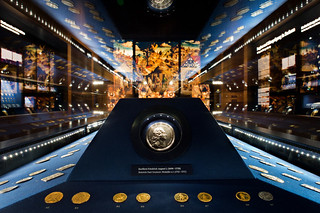
PREV ARTICLE
NEXT ARTICLE
FULL ISSUE
PREV FULL ISSUE
G7 MINISTERS VISIT GERMANY’S ANCIENT COIN COLLECTION
Germany's Numismatic Cabinet has several high-profile visitors during the recent G7 summit. -Editor
Their jaunt was to take place after a working lunch in Dresden’s Royal Palace on Thursday. It was early afternoon, 2:15 pm, and a handful of museum and government officials had already gathered in the Numismatic Cabinet which, as a part of the State Art Collections, is also located in the palace. They were waiting for Schäuble and others to arrive. But they didn’t know who the others would be because, as one nervous official put it, “you can’t really force a US Treasury Secretary to look at a coin collection instead of, say, going to his hotel room and phoning his wife.” Though the event had initially been planned as a low-key affair — just some of the world’s most eminent finance ministers face-to-face with some of the world’s most eminent coins — a couple of journalists had been granted access, too. A team from the regional news network was battling a documentary filmmaker and an in-house crew over who would get to shoot the finance ministers looking at cash from the best angle. (Call it the money shot.) The regional news producer pushed her luck by suggesting that she needed an image of Schäuble “taking a coin into his hands.” The museum officials firmly told her that no such thing would be possible, insinuating the coins were too precious even for a German finance minister to get his hands on. Visiting a coin collection may seem a little dull in comparison to other pastimes preferred by world leaders. George W. Bush invited state guests to barbecues on his Texan ranch. Boris Yeltsin asked fellow world leaders to join him in the sauna, Bill Clinton played the saxophone. But Schäuble’s choice of venue in Dresden did befit a summit that, according to the German finance ministry, was all about the question of how to reconcile growth policy with fiscal prudence. The Dresden Numismatic Cabinet consists of four ridiculously high-ceilinged rooms, once inhabited by Saxon aristocrats, that were expensively refurbished for the sole purpose of exhibiting tiny coins. One Saxon Duke, George the Bearded, founded the Numismatic Cabinet in the 16th century. The collection has moved around a lot since then — it even spent some time in Moscow after Red Army soldiers seized it as a war trophy. As of this summer, the coins are back where they originally belong, and the cabinet will be reopened to the public next week. Since the federal government paid for some of the refurbishing costs, museum officials knew Schäuble well enough and invited him to visit during his stay in Dresden. At about 2:30 pm, Schäuble moved briskly ahead into the cabinet lobby. He shook hands with Museum Director Hartwig Fischer and Cabinet Director Rainer Grund. He was given a coffee-table tome called “Competition in Ore: The Portrait Medal in the German Renaissance.” In return, he presented museum officials with a collector’s edition of ten German-made €2 coins. (The set sells for less than €50 on Ebay.) Fischer gave a little speech, mentioning that the collection consists of a total of 300,000 coins, most stashed away in metal cabinets. “300,000!,” Schäuble exclaimed, pursing his lips in appreciation. Then the show began, starting with a commemorative medal that dates back to 1690. Its face depicts a Saxonian silver mine and a quasi-divine hand reaching down from the sky and presenting a coin. The image signifies that the value a silver mine depends on investments, Grund helpfully explained. He then moved on to Imperial Germany’s most expensive piece, a 3 Deutsche Mark coin celebrating the 400th anniversary of Martin Luther’s reformation and the exhibit’s heaviest gold coin (348 grams). Asked whether he expected the international finance ministers to learn something new, Grund said that he only wanted to “leave an impression of the beauty and diversity of this historical coin collection.” The visitors then entered a dark room with a suspended ceiling and no windows; the part of the exhibit devoted to the history of money, from the ancient Greek drachma to the present-day euro. Schäuble asked to see the collection’s oldest piece and was shown a coin the size of a cufflink dating back to 600 BC. At this point, French finance minister Sapin came alive, showing numismatic expertise and pointing to exhibits he identifed as Lydian and Greco-Bactrian. “Une très belle collection,” he said, moving on to the next room. Other finance officials seemed less impressed. They huddled together at the other end of the room and laughingly pointed at a euro coin minted in Greece. Only thirty minutes had been allotted for the tour — a tight schedule considering the history of money spans thousands of years. Grund managed to squeeze in two more objects before concluding the tour. The first, an early 18th century medal, depicted the Saxon king Augustus the Strong as Hercules fighting a many-headed Hydra. The other was a war medal donated by Frederick Augustus II, Elector of Saxony. Finance Minister Schäuble, who’d listened attentively until now, got impatient. He slapped his thighs and said: “Oh well, we have to go.” Five minutes later, no finance minister remained, and the coin cabinet was empty. The money show was over. To read the complete article, see:
THE BOOK BAZARREWayne Homren, Editor The Numismatic Bibliomania Society is a non-profit organization promoting numismatic literature. See our web site at coinbooks.org. To submit items for publication in The E-Sylum, write to the Editor at this address: whomren@gmail.com To subscribe go to: https://my.binhost.com/lists/listinfo/esylum All Rights Reserved. NBS Home Page Contact the NBS webmaster 
|
